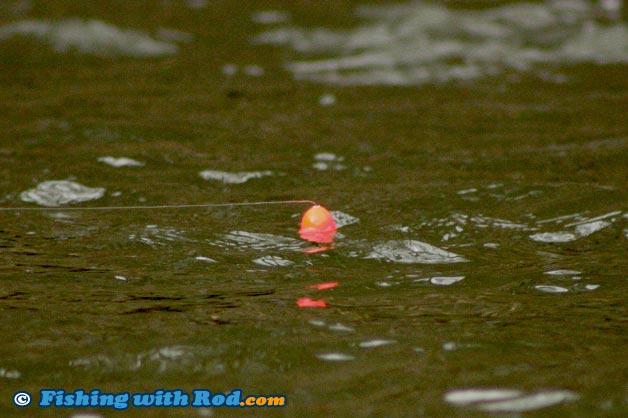Float Depth Adjustment for River Fishing
By Rodney Hsu, Fishing with Rod | Published in April 2012

The most commonly asked question that I've encountered about river float fishing is, how deep should the float depth be? It is a dilemma which novice anglers tend to struggle with. If the float depth is adjusted too long, then you are likely to snag the bottom. If the float depth is adjusted too short, then you are less likely to catch fish because they cannot find your bait. Even after float fishing for salmon in rivers since the mid 90's, I too fail to find the correct depth at times. Float depth adjustment is not an exact science, you can only become good at it by experimenting, but there are some rules which I like to follow so my success can be maximized.
Leader Length
Before figuring out the float depth, you need to determine how long your leader length should be. The leader is the line which you tie to the end of the main line, where the weight is attached to. The hook is tied to the other end of the leader. The length between the weight and the hook is usually kept between 1 to 3 feet long. This length depends on the speed of the river current.
If the river is fast and turbulent, then your leader can be as short as 1 foot long. If the leader is too long, the current will carry the bait away from the bottom. A short leader keeps the bait close to the weight, which remains in the strike zone even in turbulent conditions.
When fishing at a run with very little current, you should lengthen your leader because the fish have more time staring at your bait. By keeping the weight further away from the hook, it may not startle the fish as much. Ideally, it is not necessary to use leader longer than 3 feet. There is always a time delay between when the fish bites your hook and when the float is pulled down. A longer leader can stretch that delay, which means possibly less hook-ups.
Judging River Depth and Current
In river float fishing, the float depth is the length between the float and the hook when they are be drifted downstream. The float depth is not always the same as the exact length between the float and the hook. River current plays a major role in this difference. The strong current can lift your weight and hook away from the river bed, so the distance between the float and hook sometimes needs to be longer than it seems.
There really isn't a technique that determines the correct depth immediately when you arrive at a run, but your accuracy will improve as you accumulate more days on the rivers. One way that I use to determine the river depth is by asking myself where the water level would be if I am standing at where I want to fish. If it is knee-deep, then a couple of feet is adequate enough between the float and the hook. If it is waist-deep, then your float depth might be between 3 and 4 feet. If you would be completely submerged, then start at six feet and work your way up. These estimates of course vary slightly based on the angler's height.
The objective is to adjust your float depth so your bait, lure or artificial fly suspends around one foot above the river bed. Salmonids typically rest just above the riverbed and feed by looking up. By drifting over your target fish, you will effectively present your offering to them and avoid foul-hooking any fish or snagging onto the bottom.
If your float starts to lean sideway or sinks repeatedly for no reason when being drifted, then your float depth is likely to be too long. Shorten it by a foot and repeat the process if needed until your float drifts properly. If you are fishing a run where fish are present but you are unable to trigger a bite, then it is possible that your float depth is too short. If this is the case, lengthen the float depth slightly to see if it makes a difference.
Other Factors
Beside river velocity, other factors are sometimes at play too. You should consider the buoyancy of your presentation. Natural bait has a tendency to float, so the float depth needs to be longer while keeping the leader short sometimes. Heavier presentations such as jigs and spinners sink quite easily, so a shorter float depth is needed to avoid snagging up.
Your target species may also influence the float depth. Coho salmon are more likely to rise from the riverbed to grab a presentation, while chinook salmon are less likely to do so. The float depth for targeting coho salmon is typically shorter than for chinook salmon.
Correct float depths place your presentation in front of the fish more frequently so your chance of catching a fish is increased. It needs to be experimented and practiced regularly if you want to be successful in float fishing for salmon, steelhead and trout.

